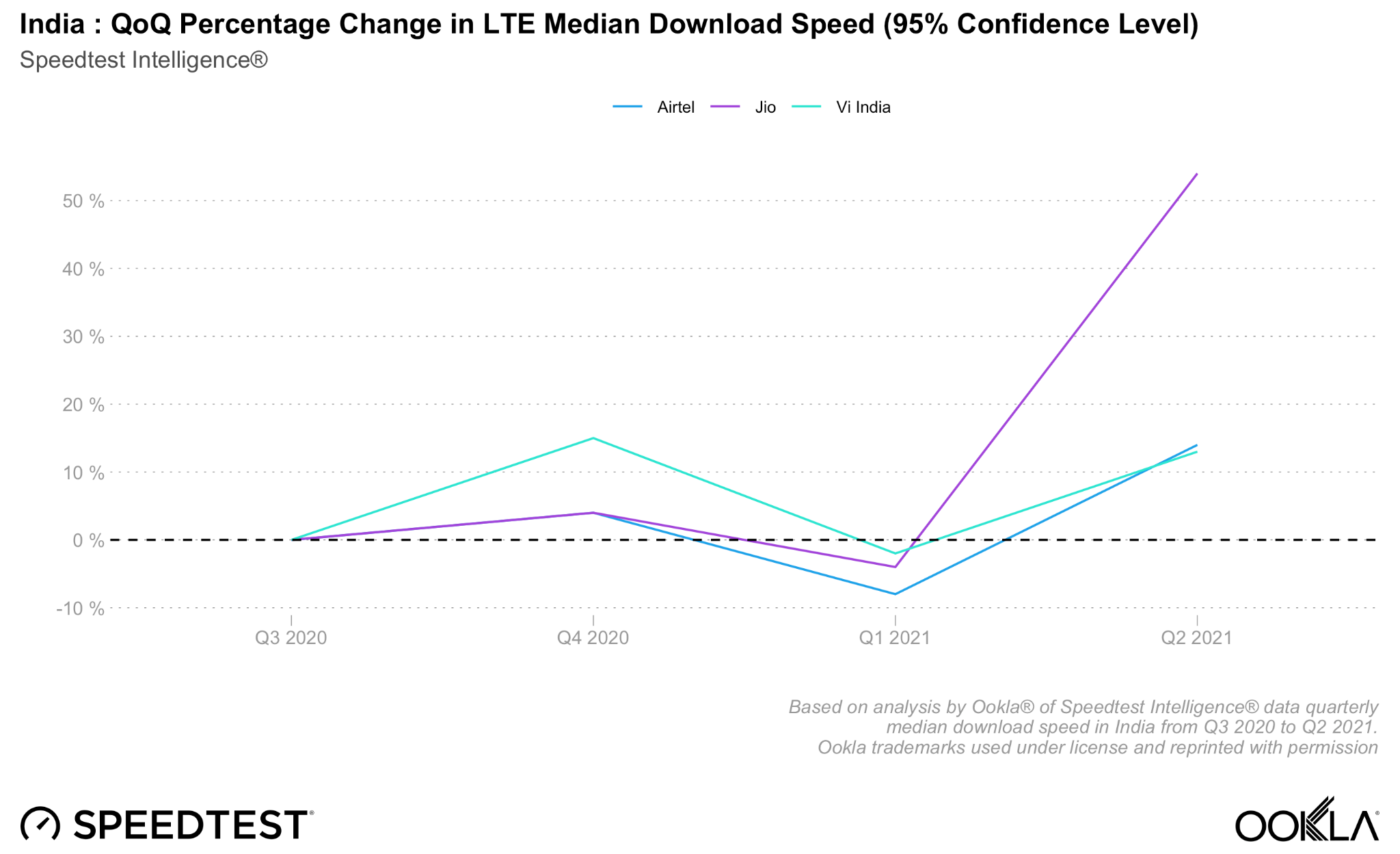
Q1. How Have Indian Telecom Operators Managed Their 4G Networks During COVID-19 (Wave 1 and Wave 2)?
Our data show an obvious difference in 4G network performance between the two waves of Covid in India. During the first wave, operators had to respond to a massive shift in traffic – from urban commercial centres to outskirts and residential areas in cities, and from urban to rural areas – as well as a growth in traffic due to the lockdown situation. On top of that, telecom operators had to contend with disrupted supply chains and an inability in many instances to physically deploy network components. During the second wave of Covid, operators were better prepared – being able to manage more of their network estates remotely but also increasing their spectrum holdings across a variety of bands. Median download speeds in India increased from 10.64 Mbps in Q1 2020 (January 1st, 2020 – March 30th, 2020) to 15.67 Mbps in Q2 2021 (April 1st 2021 – June 30th, 2021), while 4G Service (the % of an operator’s known locations where a device has access to 4G LTE service) hit 97% in the same quarter, up from 93.5% at the end of 2020.
Q2. Which Operator Is Providing the 4G+ Network to the Users in Most Regions of the Country?
Jio is the leader of the pack in Q2 2021 when we look at its coverage data, both for 4G Service, 4G Availability and Coverage Score. This means that a greater share of its known locations provides 4G-LTE access, that more of its users spend time on 4G-LTE networks, and that it has the widest high-quality 4G-LTE network in the country. This underlines the impact Jio has had in helping bridge the digital divide to bring affordable internet to more remote parts of the country.Q3. Besides Speedtest, Which Is a Very Popular Application Being Used by a Lot of Consumers in India, What Are Other Business Strategies by Ookla for India?
Every month, millions of users across India test their networks with Speedtest by Ookla, which is no surprise given data consumption in the market – Ericsson’s latest Mobility Report ranks the market as one of the regions with the highest mobile data use per smartphone globally, at 14.6GB per month. This is well above the global average of 9GB. Additionally, Speedtest Awards™, presented by Ookla, are an elite designation reserved for fixed and mobile providers in a market. Based on consumer-initiated tests and background scans from Speedtest applications, Speedtest Awards represent real-world network performance and the internet speeds and coverage provided to customers. We are also focused on delivering new features to help consumers better understand their connected experiences and how that compares locally and globally.Q4. How Behind India Is Compared to Nations Such as the U.S. and the U.K When It Comes to 5G?
Although India is lagging behind markets with robust 5G deployments like the UK and US, Indian providers are making great strides. It’s clear there’s a large amount of work going on behind the scenes to help drive 5G commercialisation once the spectrum becomes available. All three major network operators are busy conducting 5G trials and have achieved very impressive 5G speeds. On top of that, Airtel has already started to roll out 5G-ready network equipment, and Jio is testing its own 5G Open RAN solutions in several cities. It’s also worth noting that there are some key benefits to the delay in India’s 5G launch. Over time, the cost of 5G hardware will fall as the technology and vendor ecosystem matures. Indian operators’ move to embrace Open RAN will drive network costs even lower. Another key factor is the 5G device ecosystem. 5G smartphone prices have already fallen since the technology launched. This trend will continue, spurred in India by partnerships such as Jio Platform’s with Google. Interestingly, we’re already seeing a growing number of results from Speedtest running on 5G capable devices in the market – indicating that there will be a pre-installed base that operators can target from day one of launch.Q5. How Fast Will 5G Really Be in Congested Networks? (If There’s Any Data From Another Nation Available)
One of the key benefits of 5G is that it can operate over a wider range of spectrum frequencies than LTE. India’s government plans to allocate a wide band of 275 MHz of spectrum in the 3.3-3.6 GHz range (C-Band), which will offer a much greater capacity than the existing spectrum used for LTE services. If we look at other Asia Pacific markets that have recently launched 5G (Thailand and the Philippines both launched 5G in Q1 2020), the differential between 4G-LTE and 5G speeds was on average between 9-10x in Q2 2021. It’s impossible to say exactly how fast 5G will be for the average Indian user, given uncertainty over exact spectrum allocations and rollout plans (including the radio access network, but also improvements to backhaul and transport networks). However, it’s safe to say that 5G will bring a considerable bump to speeds in the country. Examples from Speedtest Intelligence data: All data is from Q2 2021 (April 1st, 2021 – June 30th, 2021) Philippines – Q1 2020 – 5G launch Q2 2021 Data:- Overall median download speed of 29 Mbps
- Median 5G download speed – 151.08 Mbps
- Median download speeds were 116% faster during Q2 2021 than Q1 2020
- Overall median download speed of 44.4 Mbps
- Median 5G download speed – 231.45 Mbps
- Median download speeds were 31% faster during Q2 2021 than Q1 2020
- Overall median download speed of 36.79 Mbps
- Median 5G download speed – 166.31 Mbps
- Median download speeds were 36% faster during Q2 2021 than Q2 2020
- Overall median download speed of 31.37 Mbps
- Median 5G download speed – 64.91 Mbps
- Median download speeds were 19% faster during Q2 2021 than Q3 2020
Q6. What Should Be the 5G Vision for India?
For Indian consumers, 5G should represent a step-change in experience over current LTE networks, providing the bandwidth and latency to enjoy uninterrupted access to services such as high-definition video streaming, mobile gaming and video calling on the go. The advent of 5G should propel the market up the Ookla Speedtest Global Index, where it currently sits in 122nd place (as of June 2021, measured by median download speeds). For Indian mobile operators and the regulator, the 5G era should be one of growing stability. With three large-scale operators, we’re unlikely to return to the price wars that occurred during the early 4G tech cycle, which is important in ensuring adequate re-investment in networks. Beyond that, I see a clear desire to be at the forefront of next-generation network technologies. This is shown by the moves to embrace Open RAN and network virtualisation by all three mobile operators, the Government’s Make in India initiative and the Indian Telecom Standard Body’s recent submission of its 6G vision to the ITU.https://ift.tt/3BENE7z
Comments
Post a Comment